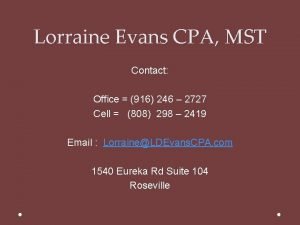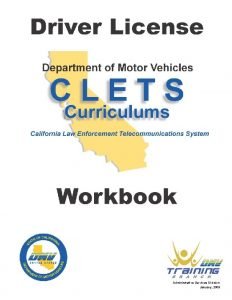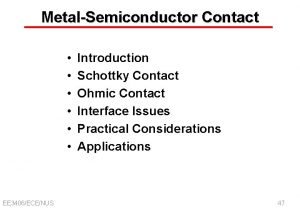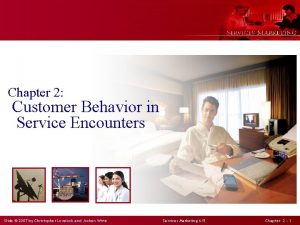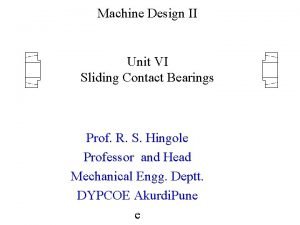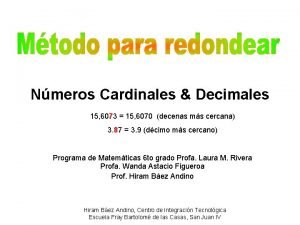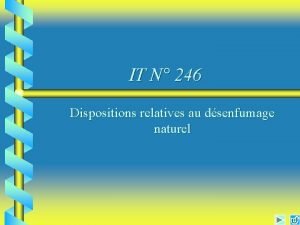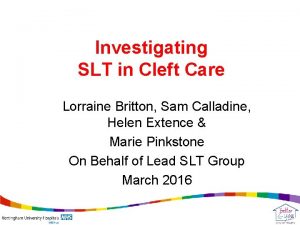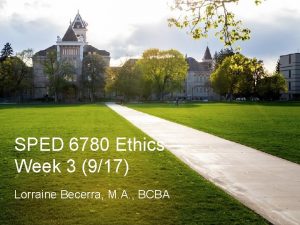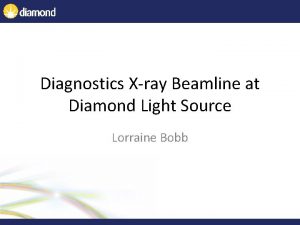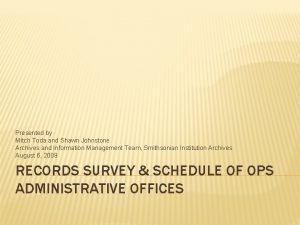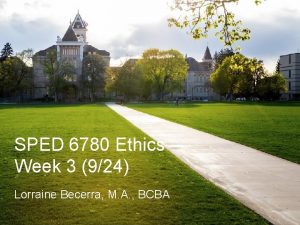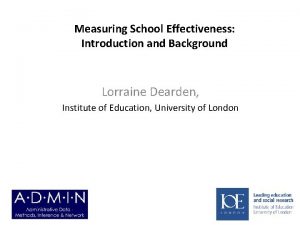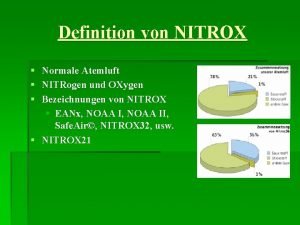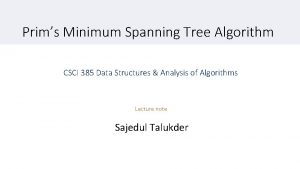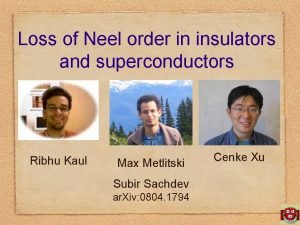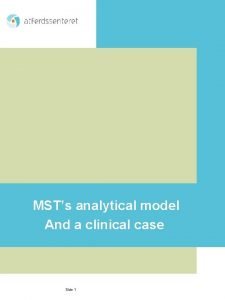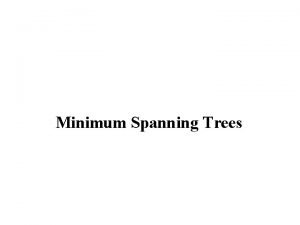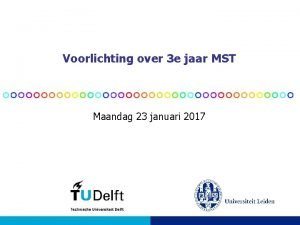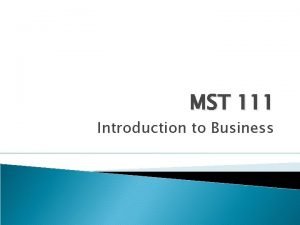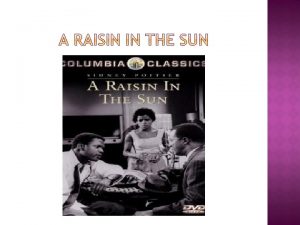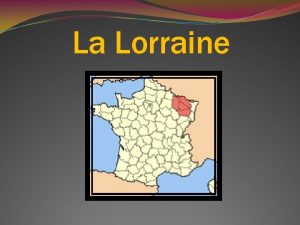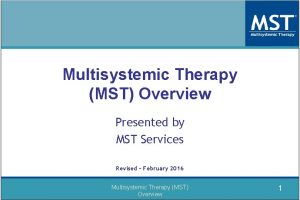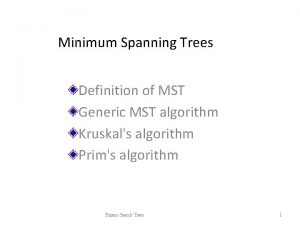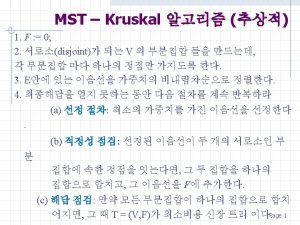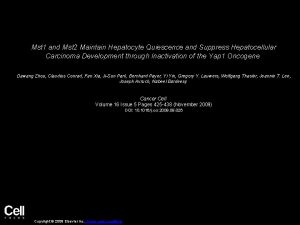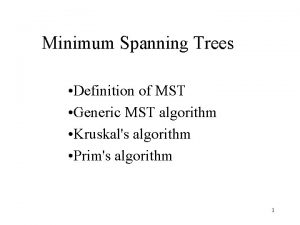Lorraine Evans CPA MST Contact Office 916 246





































































- Slides: 69

Lorraine Evans CPA, MST Contact: Office = (916) 246 – 2727 Cell = (808) 298 – 2419 Email : Lorraine@LDEvans. CPA. com 1540 Eureka Rd Suite 104 Roseville



What business am I operating? • Determine what your “business” is doing • Discern between “investment activities” and “business activities”

When am I operating a Business? • Operating for profit - sales of products, services • Examples of Real Estate Businesses: • Realtor or Broker that assists clients in buying and selling real estate and receives commissions • Flipping properties with the intent of quickly realizing a profit – regular and continuous • Wholesale property for commission • Deal structuring for commission or share of profit

Investment Activity is NOT a Business • Most confusing area for Real Estate Investors • Holding property for long term gain and passive income is an INVESTMENT • Occasional sales (FLIPPING) can be INVESTMENT • Owning an INVESTMENT is not the same as operating a BUSINESS

Business vs. Investment • • Business generates employment type income Taxed as ordinary income, self-employment income Business deductions allowed to offset income Investment income generates passive income – no self employment taxes • Taxed as capital gain or other passive income • Investment expenses on each particular investment are allowed – get traced to each activity

Dealer or Investor? • • Investor – Passive Income Dealer – Business Income (S. E. Tax!) Investor sells “investment” (Schedule D) Dealer sells “inventory” (Schedule C, LLC, or Corporation)

Dealer or Investor? • Was property held primarily for sale to customers? • 3 requirements • 9 factors

Dealer or Investor? ? • At the time of sale – was the property held primarily for SALE? ? • Is the taxpayer engaged in a trade or business? • Holding the property primarily for sale in that business • Sale of the property is ordinary for that business

9 Factors to Consider • • Purpose for which property INITIALLY acquired Purpose for which property SUBSEQUENTLY held Extent of improvements made to the property Frequency, number and continuity of sales Extent and substantiality of disposition of property Extent and nature of your business Extent of advertising and other active efforts used in soliciting buyers for the sale of the property • Listing of the property for sale through a broker • Purpose for which property was held at the time of disposition

Real Estate Activities • Real Estate INVESTING is NOT a business • Forming an entity to operate your real estate does not turn it into a BUSINESS • Forming an Entity to operate your INVESTMENT activities is a good idea • Forming an Entity to operate your BUSINESS activities is even MORE IMPORTANT !


• Why am I showing all these cute pictures of my granddaughter? ? ? • Royalties – or wages • Start funding her ROTH IRA NOW • Divert income to HER Hire your kids!

How should I operate and structure my business? • • Consider both tax and non-tax issues Ownership currently and in the future Legal liability protections Employees and employee structure Exit strategy – full life cycle of the business Ability to attract capital And of course – INCOME TAXES !

Four Basic Choices 1. 2. 3. 4. Sole Proprietorship Partnership – General or Limited Corporation – C or S Limited Liability Company (LLC)

Sole Proprietorship • Owned and operated by one individual (or spouses) • Not a separate legal entity – no legal registration needed • Can use a DBA for anonymity • Usually need a business license • Business ceases upon death or sale • NEVER used for investment activities

Sole Proprietorship – Con’t • No legal or liability protection • All income reported on your personal tax return – Schedule C • Self-employment taxes • No transparency from IRS scrutiny • All your tax info disclosed to third parties when tax returns inspected

Partnership – General & Limited • Relationship between two or more persons to conduct a trade or business • Also used to hold investment activities when multiple owners involved • Partnership agreement not required by law – but a good idea to have one !

General Partnership • • • 2 or more partners Business operates under partnership name Creditors often want personal guarantees NO LIABILITY PROTECTION Income taxed as employment income All income passes through to the individual owners and taxes get paid by the owners – NOT the partnership

Limited Partnership • Must be ONE general partner who is liable for partnership liabilities • The limited partners are NOT at risk • Normally are not active in the business • Losses passed through could be limited under passive activity rules • Income or loss gets passed through and reported on the owners tax returns • In CA – must register with Secretary of State and pay $800 annually

Corporation • Formation of legal entity • Articles of Incorporation, Bylaws, Corporate Officers, Minutes and Board Meetings required • Limited liability • Considered separate entity from the owners • Sometimes still requires personal guarantees from the owners for the corporations debts

Regular C Corporation • • Company files 1120 and pays tax on the income Owners pay tax on salary paid to them for services and/or Dividends on profits retained by corporation that are paid out Personal Service Corp pays tax at flat 35% rate instead of the graduated tax rates No ownership restrictions – any entity can own stock Well established body of law in case of legal issues Limited liability Generous fringe benefit programs

Regular C Corporation – Con’t • Double taxation – income taxed at corporate level and again at individual level • No capital gain tax rates allowed • Costs of operating, reporting, maintaining • Corporate losses do not benefit owners • Stricter accounting rules – such as accrual accounting

Subchapter S Corporation • • C Corporation that ELECTS to be taxed as an S Corporation Like a C Corporation and a Partnership combined Still have limited liability Income passes through to the owners and the tax is paid on the owners tax returns • Only natural persons may own stock • Active owners are required to take “REASONABLE” salary – opportunity to save on employment taxes • No special allocations allowed – items need to be prorata in direct proportion to ownership

Limited Liability Companies • Can be multiple member or single member • Single member includes married couples • Can elect to be taxed as sole proprietorship, partnership, S Corporation or C Corporation • Default treatment is Partnership if multiple owners and no election is made • Provides legal liability protection • Easy to form, easy to operate, easy to dissolve

Limited Liability Companies – Con’t • • • No limit on number or type of owner Special allocations allowed Income and losses flow through to the owners Tax free distributions of property Operating agreements are advised – particularly if you have a self-directed IRA involved • Still have issue of employment taxes on business income for general active members

So how do I choose? • Type of entity depends on a number of factors • Start by talking to your tax professional • You can save taxes and avoid a lot of potential problems if you get guidance BEFORE you form your entity • Fixing problems after the fact is time consuming, and often costly


Proper Characterization of Repairs vs. Improvements Maintenance – prevents breakdowns Repairs – AFTER a break down occurs Improvements - you need to take depreciation deductions

The NEW Rules – 3 Safe Harbors Small Taxpayer Safe Harbor Your income must be less than $10 m The basis of the building must be less than $1 m Total allowed is the LESSER of $10, 000 OR 2% of the unadjusted basis of the property Year by year election Building by building determination

The NEW Rules – 3 Safe Harbors Routine Maintenance Safe Harbor Expenses qualifying as routine maintenance automatically deductible in full in a single year Inspection, cleaning, testing of building structure and/or each building system Replacement of damaged or worn parts with comparable and commercially available replacement parts

Routine Maintenance Safe Harbor Two BIG limitations: Ten year rule – must reasonably expect to perform the maintenance MORE than once every ten years No betterments or restorations – and must be during YOUR use of the property, not a previous owner No remodels or replacements

De Minimus Safe Harbor Amount increased from $500 to $2, 500 Per INVOICE OR ITEM Begins taxable years on or after January 1, 2016 Annual election that must be made on each year’s timely filed tax return (including extensions)


Maximize Your Depreciation Deductions

What is Depreciation? • Allowance for wear and tear on property • Method to budget for replacement costs • Annual NON Cash deduction against rental income

Maximizing Depreciation • Shorter life of asset = faster write off • Some assets get a “BONUS” first year deduction – historically it has been either 100% or 50% • Currently in the tax law, 50% bonus on “NEW” assets placed in service

Land vs. Building – Determine Proper Allocation Land has NO depreciation Buildings = 27. 5 years (Residential)

Land Improvements 15 year : Fences Driveways Landscaping Shrubbery

Structural Components Versus Tangible Personal Property � Structural Components = 27. 5 years � Tangible Personal Property = 5 years (plus bonus depreciation if new) • • Flooring Cabinets Appliances Furniture, etc…

§ Cost Segregation is a strategic tax savings tool that allows companies and individuals, who have constructed, purchased, expanded, or remodeled any kind of real estate to increase cash flow by accelerating depreciation deductions and deferring federal and state income taxes.

§ Each CPA will use their own EXPERIENCE and JUDGEMENT § There is no formal engineering study done § An estimation of various personal property costs is utilized § Can use this for self-directed IRA to minimize UDFI taxes on financed properties

§ Make initial land to building cost allocation § We rely on the property tax statements for this information § Sometimes it is NOT reliable

§ After identify land cost allocation § Identify land IMPROVEMENT costs § Items such as driveways, sidewalks, landscaping, sprinkler systems, fences, etc. § Most of these items have a 15 year life § When available, these assets also qualify for BONUS depreciation

§ Identify building costs using cost segregation analysis § In cases where the cost of an analysis is NOT justified, you can use an allocation § “IF IT CAN BE SUPPORTED”

§ Total cost of property – duplex = $625, 000 § Step one – determine land value = $190, 000 (taken from either property tax statement or comparable values of other properties in the area) § Step two – determine land improvements – determine extent of fencing, landscaping, driveways, walkways, etc = let’s assume 15% = $28, 500

§ Step three = identify building costs of personal (as contrasted with real) property § Let’s assume $625, 000 less the $190, 000 allocated to land leaves $435, 000 § Estimate 20% for personal property = $87, 000

Asset Allocation Example

Asset Allocation Example

Asset Allocation Example

§ By categorizing property as 5 or 15 year property – you change the recapture rules § Real property you recapture the depreciation at a FIXED rate of 25% § Personal property you recapture the depreciation at your ORDINARY tax rate

§Depreciation recapture is limited to the total GAIN on the disposition of the property §Allocate the sales price to the assets according to the value of the assets at the sales date

§ The market value of the assets will likely be LESS than the amount you allocated on the purchase § 5 year old carpets and appliances are not worth much ! § Minimize recapture by allocating ONLY the true remaining value of those assets

Example on sell

End Results


Partial Disposition Rules • Rules and guidance when PART of a structure is replaced WITHOUT separately identifying the component BEFORE the disposition occurs • This is also an ELECTION you must make on a timely filed return (including extensions) on the year the DISPOSITION is made – NOT THE REPLACEMENT YEAR • A REASONABLE METHOD may be used to determine the unadjusted depreciable basis • If we have to replace it, we can dispose the OLD and Capitalize the NEW

Partial Disposition • We will remove BOTH the cost AND the accumulated depreciation – so we will not need to recapture that depreciation later • We will get a LOSS for our tax return as the sales price is of course ZERO

Partial Disposition • Lets replace the ROOF – Old Roof comes off, New Roof goes on • You did not do any SEGREGATION for the Roof when you put it in service – the cost is lumped in with the total cost of the property • We need to EXTRACT the cost of that OLD Roof ! • And when we write the cost off , the sales price is of course ZERO • And – we can also write off the removal costs !

The “STEPS” • • Measure cost of replacement property Work BACKWARDS to measure historical cost Need a RATE OF CHANGE Discount present day cost back to historical cost Segregate basis and depreciation Dispose of partial asset: calculate loss Capitalize and begin depreciation NEW asset

Example • Process is fairly complicated – but, again, IRS says we can use any REASONABLE method !! • Original bldg • • Basis $250, 000 Accum depr $20, 833 AFTER segregation: Building basis $238, 465 Accum depr $19, 872 Old roof $ 11, 535 Accum depr $ 961 New roof $ 12, 000 • Loss on disposition = $ 10, 574 – deductible NOW

Complexity • The complex part is the discounting of the replacement property – but we can figure that out !!!

Resources • www. calculatorsoup. com/calculators/financial/de preciation-property-realestate. php • Depreciation calculator • https: //kbkgsolutions. com • Cost segregation calculator = $399 per property • Partial disposition calculator - $499 year, or $49 for 24 hours

Real Estate Investments – Ending Ownership Ending the Investment – Fully Taxable Sale • Paid in full – all gains taxed • Partial payment – seller financing is taxed as you collect principal • Depreciation recapture: 1. ordinary – 1245 2. 25% - 1250 3. remainder – LTCG rates

Real Estate Investments – Ending Ownership Tax Deferred Exchange – 1031 • Held for investment • Like kind • 45 day id required • 180 day receipt of property • Forward exchange / reverse exchanges • Qualified intermediary • Partially taxable 1031 exchanges


QUESTIONS?

Lorraine Evans CPA, MST • Office = (916) 246– 2727 • Cell = (808) 298 2419 • Email : Lorraine@LDEvans. CPA. com • 1540 Eureka Rd Suite 104 • Roseville
 Lorraine evans cpa
Lorraine evans cpa 916-657-8101
916-657-8101 What is dangling bond
What is dangling bond Contact and noncontact forces
Contact and noncontact forces Service marketing chapter 2
Service marketing chapter 2 Non contact force examples
Non contact force examples Irritant vs contact dermatitis
Irritant vs contact dermatitis Force and motion
Force and motion Friction unit
Friction unit Air resistance non contact force
Air resistance non contact force Contact and non contact forces
Contact and non contact forces Which is a contact force? *
Which is a contact force? * Cómo se escribe una decena de millar más 3 centésimos
Cómo se escribe una decena de millar más 3 centésimos En un zoológico hay 246 aves
En un zoológico hay 246 aves Cs 246
Cs 246 Extendible hashing visualization
Extendible hashing visualization It 246
It 246 246 regel diabetes
246 regel diabetes What is 517 rounded to the nearest ten
What is 517 rounded to the nearest ten Cs 246 stanford
Cs 246 stanford Afman 10-246
Afman 10-246 Ds. p. van veen
Ds. p. van veen Cs 246 stanford
Cs 246 stanford Place value of 246
Place value of 246 Baeckeoffe pronunciation
Baeckeoffe pronunciation Lorraine britton
Lorraine britton Des sports
Des sports Www.scois.net
Www.scois.net A raisin in the sun background
A raisin in the sun background What does beneatha's hair most likely symbolize
What does beneatha's hair most likely symbolize Lorraine fende
Lorraine fende Lorraine craig
Lorraine craig A house a home by lorraine m halli
A house a home by lorraine m halli Dr lorraine johnstone
Dr lorraine johnstone Lorraine bock
Lorraine bock Ron and lorraine miller
Ron and lorraine miller Dr lorraine walsh
Dr lorraine walsh Lorraine becerra
Lorraine becerra Lorraine azam
Lorraine azam Lorraine forrest-turner
Lorraine forrest-turner Chapelle sixtine lorraine
Chapelle sixtine lorraine Anencephaly
Anencephaly Lorraine danaher
Lorraine danaher Lorraine griscavage-frisbee
Lorraine griscavage-frisbee A stanislas le bienfaisant la lorraine reconnaissante
A stanislas le bienfaisant la lorraine reconnaissante Diren lorraine
Diren lorraine Lorraine bobb
Lorraine bobb Shawn johnstone
Shawn johnstone Lorraine becerra
Lorraine becerra Lorraine millard
Lorraine millard Lorraine phelan
Lorraine phelan Lorraine dearden
Lorraine dearden Lorraine smith effekt
Lorraine smith effekt Zonal education office embilipitiya contact number
Zonal education office embilipitiya contact number Arne kutzner
Arne kutzner Electric field units
Electric field units Physics 1135 mst
Physics 1135 mst Prim's algorithm pseudocode
Prim's algorithm pseudocode Mst bike
Mst bike Antiferromagnet
Antiferromagnet Tmmkm
Tmmkm Physics
Physics Mst analytical process
Mst analytical process Prim algorithm pseudo code
Prim algorithm pseudo code Minors tu delft
Minors tu delft Mst damon
Mst damon Desinficerende vaskemiddel
Desinficerende vaskemiddel Mst 111
Mst 111 Mst physics 1135
Mst physics 1135 What is mst
What is mst
